oil pressure OLDSMOBILE SILHOUETTE 2003 Owners Manual
[x] Cancel search | Manufacturer: OLDSMOBILE, Model Year: 2003, Model line: SILHOUETTE, Model: OLDSMOBILE SILHOUETTE 2003Pages: 466, PDF Size: 21.55 MB
Page 158 of 466
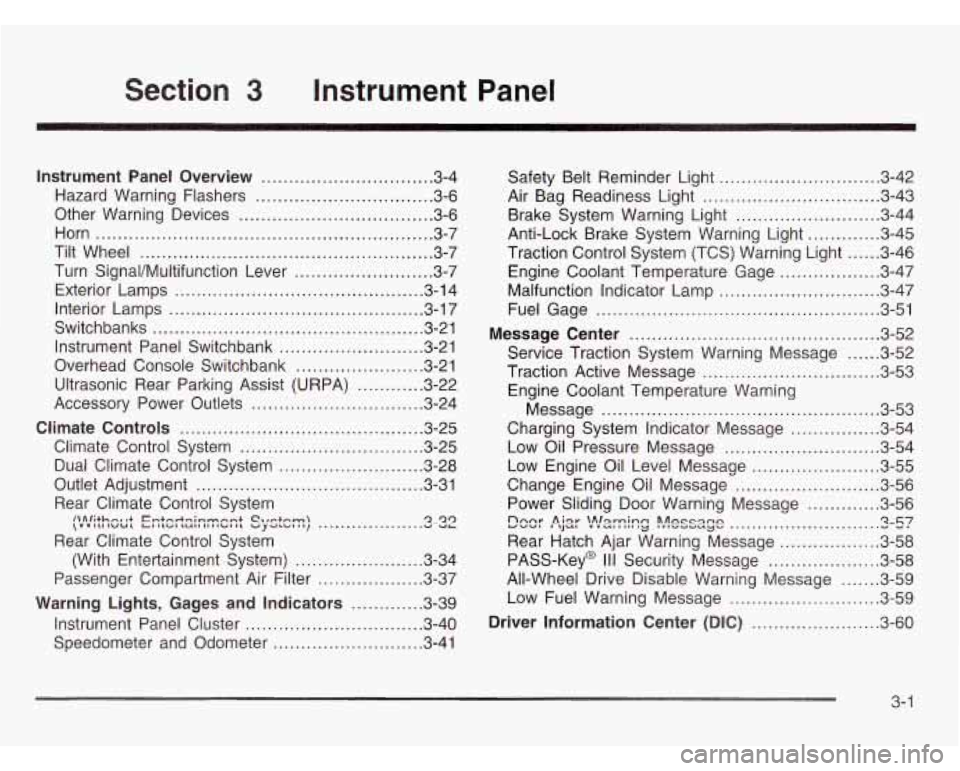
Section 3 Instrument Panel
Instrument Panel Overview ........................... 3.4
Hazard Warning Flashers
............................ 3.6
Other Warning Devices
............................... 3.6
Horn
............................................................. 3.7
Tilt Wheel
..................................................... 3-7
Turn SignaVMultifunction Lever
......................... 3.7
Exterior Lamps
............................................. 3.14
Interior Lamps
.............................................. 3.17
Switchbanks
................................................. 3.21
Instrument Panel Switchbank
.......................... 3-21
Overhead Console Switchbank
....................... 3.21
Ultrasonic Rear Parking Assist (URPA)
............ 3.22
Accessory Power Outlets
............................... 3.24
Climate Controls
............................................ 3.25
Climate Control System
................................. 3.25
Dual Climate Control System
.......................... 3.28
Rear Climate Control System
Rear Climate Control System (With Entertainment System)
...................... -3-34
Passenger Compartment Air Filter
................... 3.37
Warning Lights, Gages and Indicators
............. 3.39
Instrument Panel Cluster
................................ 3.40
Outlet Adjustment
......................................... 3.31
ilAlM-.nr I+ lZmtnwtq;n-mnt Ctrctnm \VUiLllWUL LIIL~ILUIIiIII~.. . Vy~L~..., .... ....... " "L 4-49
Speedometer and Odometer ........................... 3.41 Safety
Belt Reminder Light
............................. 3.42
Air Bag Readiness Light
................................ 3-43
Brake System Warning Light
.......................... 3-44
Anti-Lock Brake System Warning Light
............. 3-45
Traction Control System (TCS) Warning Light
...... 3-46
Engine Coolant Temperature Gage
.................. 3-47
Malfunction Indicator Lamp
............................. 3-47
Fuel Gage
................................................... 3-51
Message Center
............................................. 3-52
Service Traction System Warning Message
...... 3-52
Traction Active Message
................................ 3-53
Engine Coolant Temperature Warning
Message
.................................................. 3-53
Charging System Indicator Message
................ 3-54
Low Oil Pressure Message
............................ 3-54
Low Engine Oil Level Message
....................... 3-55
Change Engine Oil Message
.......................... 3-56
Power Sliding Door Warning Message
............. 3-56
Rear Hatch Ajar Warning Message
.................. 3-58
PASS-Key@
I II Security Message ................... -3-58
All-Wheel Drive Disable Warning Message
....... 3-59
Low Fuel Warning Message
........................... 3-59
Driver Information Center (DIC)
....................... 3-60
Eee: P, jar '!!s:n?!g !!esss;e .......................... ... Iz-c;7 v .
3- 1
Page 211 of 466

Charging System Indicator Message
The charging system
battery symbol will come
on in the message
center when you turn on
the ignition as a check
to show you it is working.
It will remain on as long as the engine is not running.
It should go out once the engine is running.
If it stays on,
or comes on while you are driving, you may have a
problem with the charging system. It could indicate that
you have problems with a generator drive belt,
or another electrical problem. Have it checked right
away. Driving while this indicator appears in the
message center could drain your battery.
Low Oil Pressure Message
LOW
OIL
PRESSURE
LL
United States Canada
Your vehicle is equipped with a low oil pressure warning
message.
Your oil pressure message lets you know when you
may have a problem with your engine oil pressure.
When the engine is running and this message appears,
the engine oil level may be too low. There may also
be another problem causing low oil pressure.
If you must drive a short distance with the message on,
be certain to turn
off all your accessories, such as
the radio and air conditioner.
3-54
Page 212 of 466
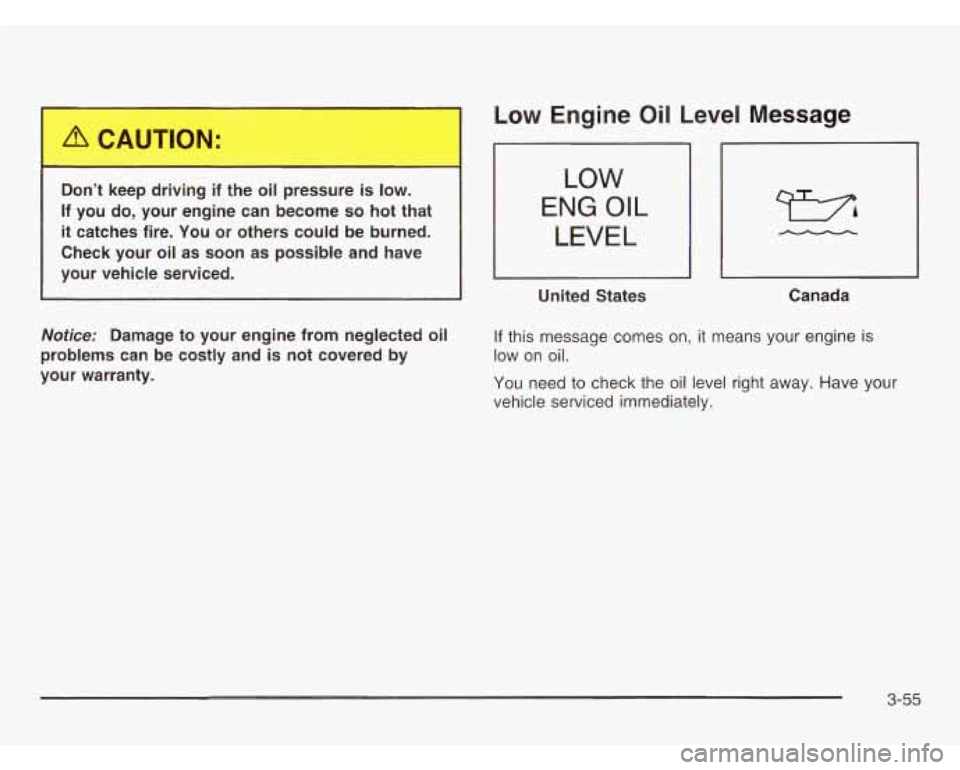
L,n’t keep driving i, .he oil pressure i, ,ow.
If you do, your engine can become
so hot that
it catches fire. You or others could be burned.
Check your oil as soon as possible and have
your vehicle serviced.
Notice: Damage to your engine from neglected oil
problems can be costly and is not covered by
your warranty.
Low Engine Oil Level Message
I I I
LOW
ENG OIL
LEVEL
I I I
United States Canada
If this message comes on, it means your engine is
low on oil.
You need to check the oil level right away. Have your
vehicle serviced immediately.
3-55
Page 286 of 466

When you want to leave the freeway, move to the
proper lane well in advance.
If you miss your exit,
do not, under any circumstances, stop and back up.
Drive on to the next exit.
The exit ramp can be curved, sometimes quite sharply.
The exit speed is usually posted.
Reduce your speed according to your speedometer, not
to your sense of motion. After driving for any distance
at higher speeds, you may tend to think you are
going slower than you actually are.
Before Leaving on a Long Trip
Make sure you’re ready. Try to be well rested. If you
must start when you’re not fresh
- such as after a day’s
work
- don’t plan to make too many miles that first
part of the journey. Wear comfortable clothing and shoes
you can easily drive in.
Is your vehicle ready for a long trip? If you keep it
serviced and maintained, it’s ready to go. If it needs
you’ll find experienced and able service experts in
dealerships all across North America. They’ll be ready
and willing to help
if you need it.
ser?l!ce, !?%.le It dene befere st2fiinCJ e$. Qf cwrse,
Here are some things you can check before a trip:
e
e
e
e
e
e
e
Windshield Washer Nuid: Is the reservior full?
Are all windows clean inside and outside?
Wiper Blades: Are they in good shape?
Fuel, Engine Oil, Other Fluids: Have you checkea
all levels?
Lamps: Are they all working? Are the lenses clean?
Tires: They are vitally important to a safe,
trouble-free trip.
Is the tread good enough for
long-distance driving? Are the tires all inflated
to the recommended pressure?
Weather Forecasts: What’s the weather outlook
along your route? Should you delay your trip a
short time to avoid a major storm system?
Maps: Do you have up-to-date maps?
4-23
Page 308 of 466
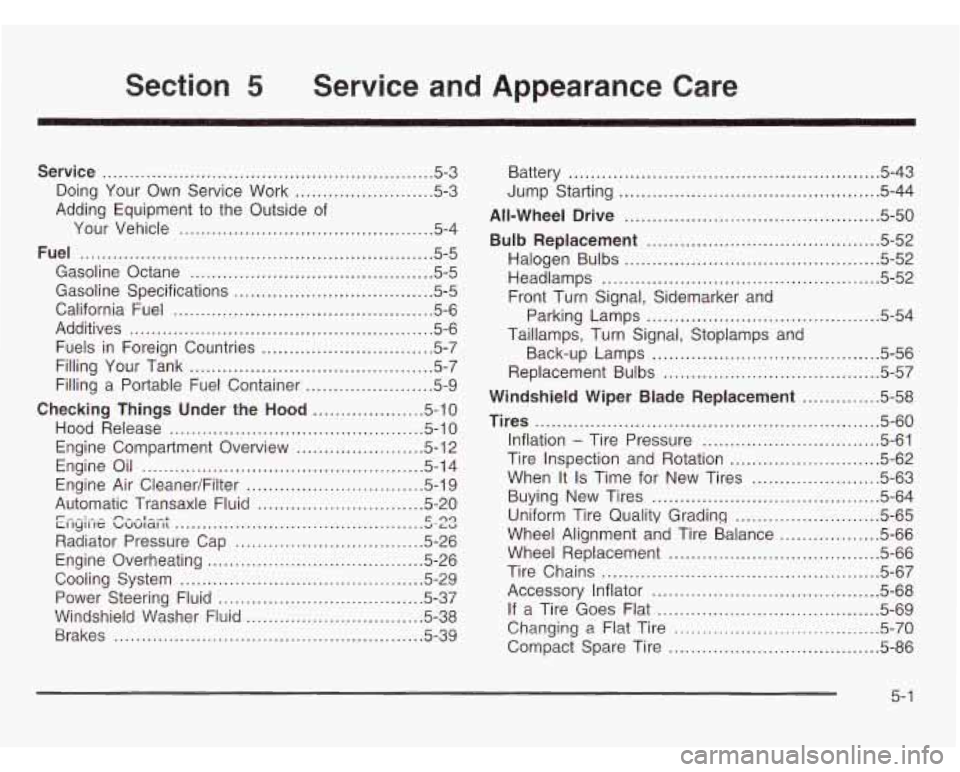
Section 5 Service and Appearance Care
Service ............................................................ 5.3
Doing Your Own Service Work
......................... 5.3
Adding Equipment to the Outside
of
Your Vehicle .............................................. 5-4
Fuel
.............................................................. -5-5
Gasoline Octane
............................................ 5-5
Gasoline Specifications
................................... 5-5
California Fuel
............................................... 5-6
Additives
....................... .... ......... 5-6
Fuels in Foreign Countries
........... ..... 5-7
Filling Your Tank
............................ ..... 5-7
Filling a Portable Fuel Container
.................... 5-9
Checking Things Under the
Hood .................. -5-1 0
Hood Release .............................................. 5-10
Engine Compartment Overview ....................... 5-12
Engine Oil
................................................... 5-14
Engine Air CleanedFilter
................................ 5-19
Automatic Transaxle Fluid
.............................. 5-20
Radiator Pressure Cap
............................... 5-26
Engine Overheating
.................................... 5-26
Cooling System
............................. , ....... 5-29
Power Steering Fluid .................. , ....... 5-37
Windshield Washer Fluid
................. , ....... 5-38
Brakes
.......................... .... ........ 5-39
r.--.:.-- ---I-.- b CI lyll IC uuvlal I1 4-LU c r)r) .............................................
Battery ........................................................ 5.43
Jump Starting
............................................... 5-44
All-Wheel Drive
.............................................. 5-50
Bulb Replacement .......................................... 5-52
Halogen Bulbs
.............................. ......... 5-52
Front Turn Signal, Sidemarker and
Taillamps, Turn Signal, Stoplamps and
Headlamps
...................................... ..... 5-52
Parking Lamps
.............................. ..... 5-54
Replacement Bulbs
....................................... 5-57
Back-up Lamps
......................................... 5-56
Windshield Wiper Blade Replacement
.............. 5-58
Tires
.............................................................. 5-60
Inflation
- Tire Pressure ................................ 5-61
Tire Inspection and Rotation
........................... 5-62
When It
Is Time for New Tires ....................... 5-63
Buying New Tires
......................................... 5-64
Uniform Tire Quality Grading
.......................... 5-65
Wheel Alignment and Tire Balance
.................. 5-66
Wheel Replacement
...................................... 5-66
Tire Chains
.................................................. 5-67
Accessory Inflator
......................................... 5-68
If a Tire Goes Flat ........................................ 5-69
Changing a Flat Tire ..................................... 5-70
Compact Spare Tire ...................................... 5-86
5- 1
Page 320 of 466
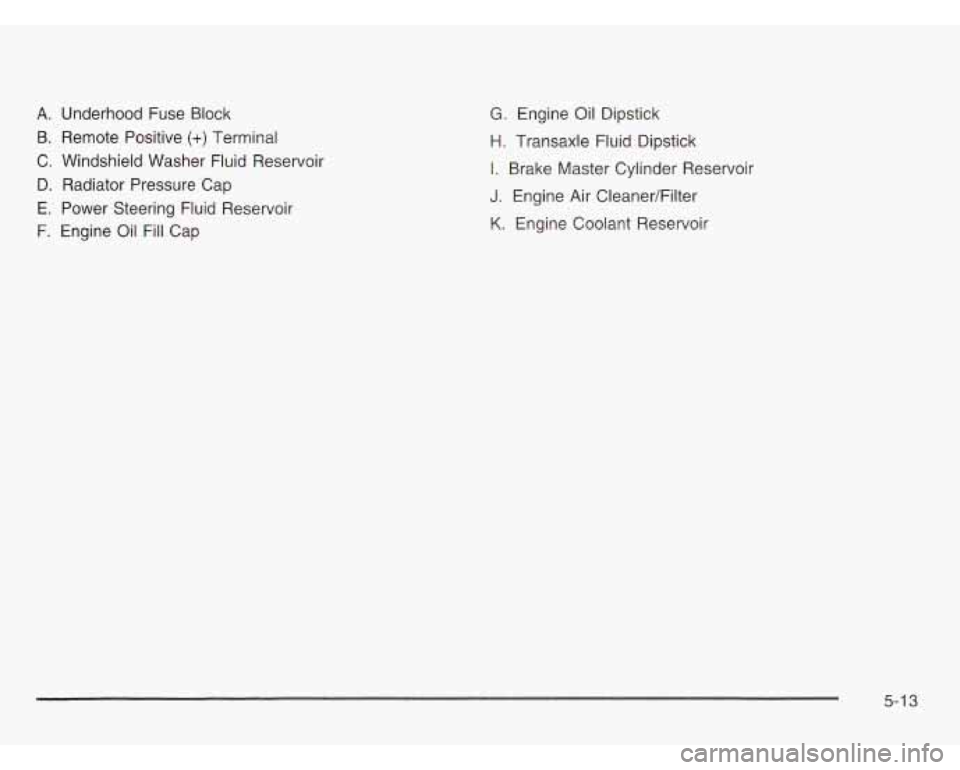
A. Underhood Fuse Block
B. Remote Positive (+) Terminal
C. Windshield Washer Fluid Reservoir
D. Radiator Pressure Cap
E. Power Steering Fluid Reservoir
F. Engine Oil Fill Cap
G. Engine Oil Dipstick
H. Transaxle Fluid Dipstick
I. Brake Master Cylinder Reservoir
J. Engine Air CleanedFilter
K. Engine Coolant Reservoir
5-1 3
Page 333 of 466
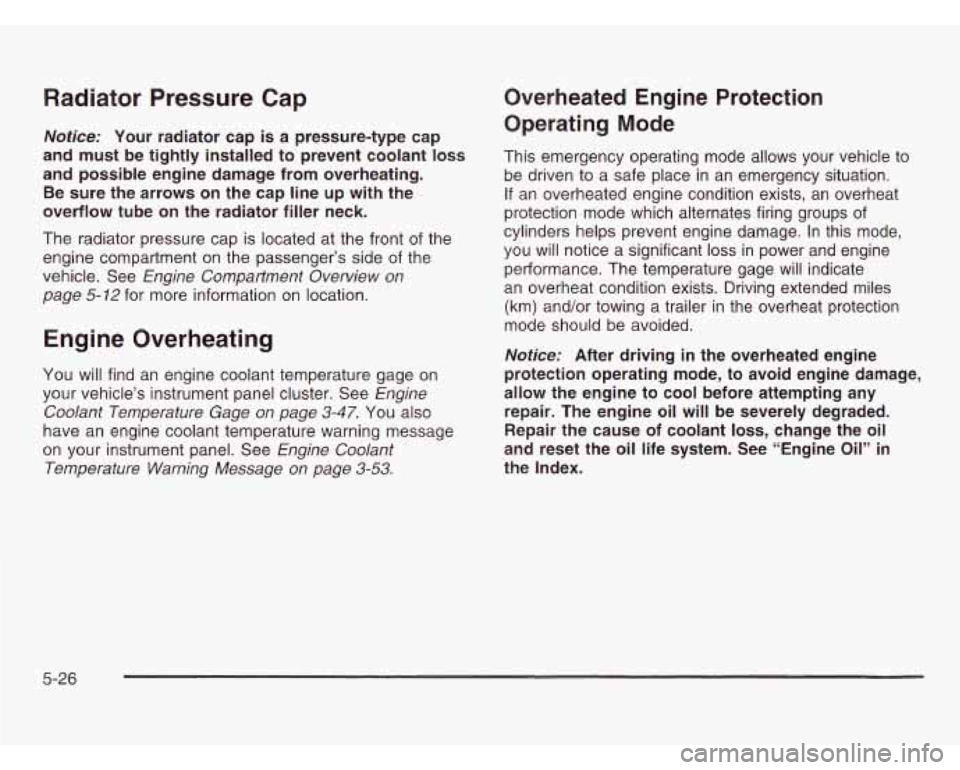
Radiator Pressure Cap
Notice: Your radiator cap is a pressure-type cap
and must be tightly installed to prevent coolant
loss
and possible engine damage from overheating.
Be sure the arrows on the cap line
up with the
overflow tube on the radiator filler neck.
The radiator pressure cap is located at the front of the
engine compartment on the passenger’s side of the
vehicle. See
Engine Compartment Overview on
page 5-72 for more information on location.
Engine Overheating
You will find an engine coolant temperature gage on
your vehicle’s instrument panel cluster. See
Engine
Coolant Temperature Gage
on page 3-47. You also
have an engine coolant temperature warning message
on your instrument panel. See
Engine Coolant
Temperature Warning Message
on page 3-53.
Overheated Engine Protection
Operating Mode
This emergency operating mode allows your vehicle to
be driven to a safe place in an emergency situation.
If an overheated engine condition exists, an overheat
protection mode which alternates firing groups of
cylinders helps prevent engine damage.
In this mode,
you will notice a significant
loss in power and engine
performance. The temperature gage will indicate
an overheat condition exists. Driving extended miles
(km) and/or towing a trailer in the overheat protection
mode should be avoided.
Notice: After driving in the overheated engine
protection operating mode, to avoid engine damage,
allow the engine to cool before attempting any repair. The engine oil will be severely degraded.
Repair the cause
of coolant loss, change the oil
and reset the
oil life system. See “Engine Oil” in
the Index.
5-26
Page 336 of 466
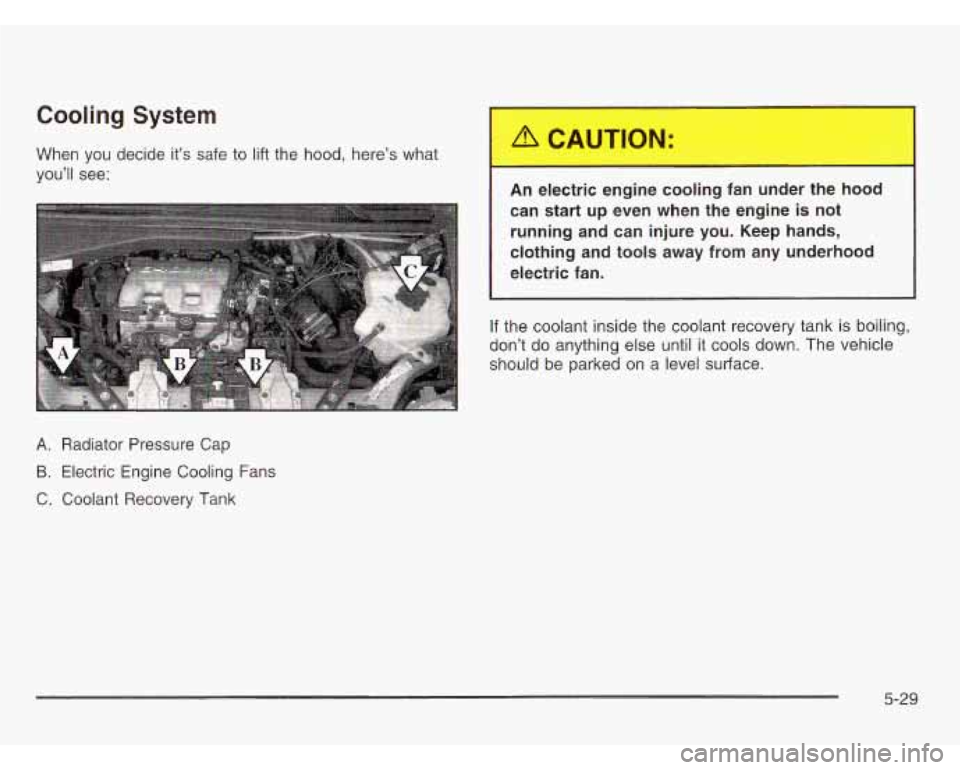
Cooling System
When you decide it’s safe to lift the hood, here’s what
you’ll see:
A. Radiator Pressure Cap
B. Electric Engine Cooling Fans
C. Coolant Recovery Tank An electric
engine cooling far. -..-er the hood
can start up even when the engine is not
running and can injure you. Keep hands,
clothing and tools away from any underhood
electric fan.
If the coolant inside the coolant recovery tank is boiling,
don’t do anything else until it cools down. The vehicle
should be parked on a level surface.
5-29
Page 423 of 466
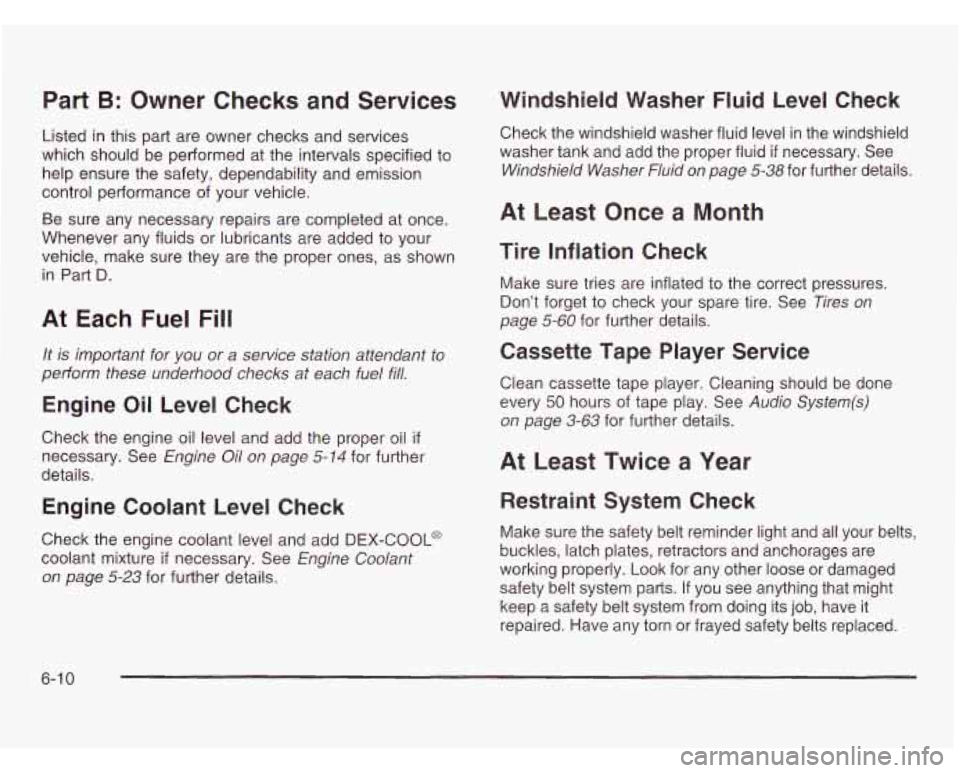
Part B: Owner Checks and Services
Listed in this part are owner checks and services
which should be performed at the intervals specified to
help ensure the safety, dependability and emission
control performance of your vehicle.
Be sure any necessary repairs are completed at once.
Whenever any fluids or lubricants are added to your
vehicle, make sure they are the proper ones, as shown
in Part D.
At Each Fuel Fill
It is important for you or a service station attendant to
perform these underhood checks at each fuel fill.
Engine Oil Level Check
Check the engine oil level and add the proper oil if
necessary. See Engine Oil on page 5-14 for further
details.
Engine Coolant Level Check
Check the engine coolant level and add DEX-COOL@
coolant mixture
if necessary. See Engine Coolant
on page 5-23
for further details.
Windshield Washer Fluid Level Check
Check the windshield washer fluid level in the windshield
washer tank and add the proper fluid
if necessary. See
Windshield Washer Fluid on page 5-38 for further details.
At Least Once a Month
Tire Inflation Check
Make sure tries are inflated to the correct pressures.
Don’t forget to check your spare tire. See
Tires on
page 5-60
for further details.
Cassette Tape Player Service
Clean cassette tape player. Cleaning should be done
every
50 hours of tape play. See Audio Systern(s)
on page 3-63 for further details.
At Least Twice a Year
Restraint System Check
:s , Make sure the safety belt reminder light and all your bell
buckles, latch plates, retractors and anchorages are
working properly. Look for any other loose or damaged
safety belt system parts.
If you see anything that might
keep a safety belt system from doing its
job, have it
repaired. Have any torn or frayed safety belts replaced.
6-1 0
Page 454 of 466
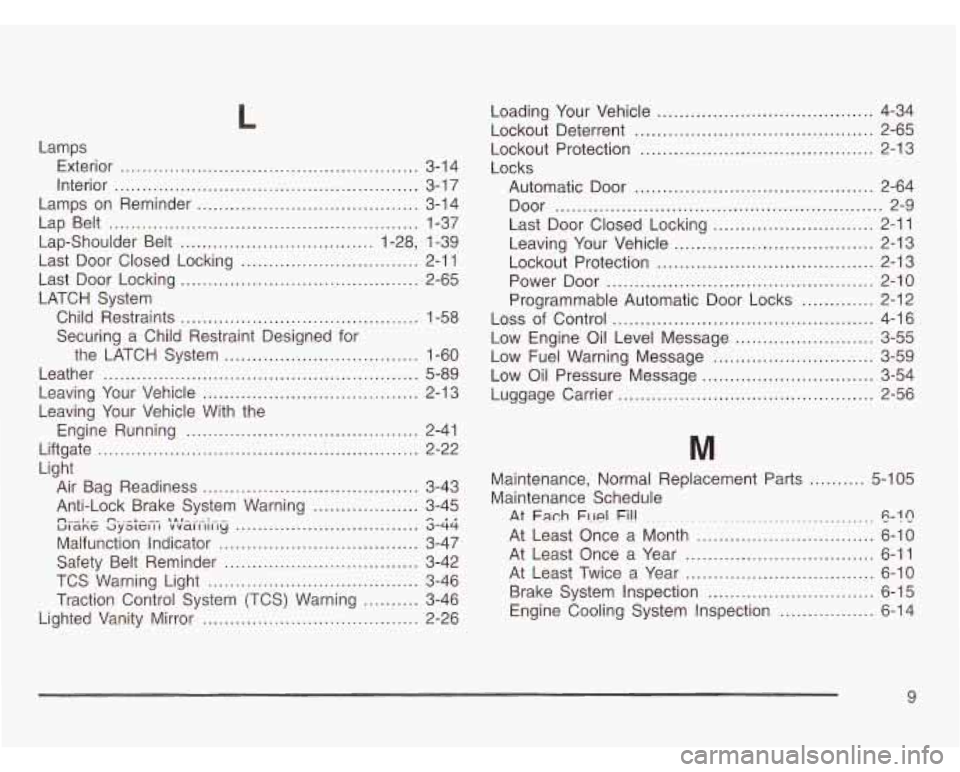
L
Lamps Exterior
..... ......................................... 3-14
Lamps on Reminder
........................................ 3-14
Lap-§boulder Belt ................................... 1-28, 1-39
Interior
....................................................... 3-1 7
Lap Belt ........................................................ 1-37
Last Door Closed Locking
................................ 2-1 1
Last Door Locking ........................................... 2-65
LATCH System Child Restraints
......................................... 1-58
Securing a Child Restraint Designed for
the LATCH System
................................... 1-60
Leather ......................................................... 5-89
Leaving Your Vehicle With the
Liftgate
.......................................................... 2-22
Light
Air Bag Readiness
....................................... 3-43
LeavifiCJ
YGl.i7 L'shicle ....................................... L- n-i I3
Engine Running .......................................... 2-41
Anti-Lock Brake System Warning
................... 3-45
ut ane 3~31~1 I I v V~II I 111 3-44
Malfunction indicator .................. .......... 3-47
Safety Belt Reminder
................................... 3-42
TCS Warning Light
...................................... 3-46
Traction Control System (TCS) Warning
.......... 3-46
Lighted Vanity Mirror
....................................... 2-26
ne-i*- n a IAI - : .................................
Loading Your Vehicle ....................................... 4-34
Lockout Deterrent
........................................... 2-65
Lockout Protection
.......................................... 2-13
Locks
Automatic Door
........................................... 2-64
Door
........................................................... 2-9
Last Door Closed Locking
............................. 2-11
Leaving Your Vehicle .................................... 2-13
Lockout Protection
....................................... 2-13
Power Door
................................................ 2-10
Programmable Automatic Door Locks
............. 2-12
Loss
of Control ............................................... 4-16
Low Engine Oil Level Message
......................... 3-55
Low Fuel Warning Message
............................. 3-59
Low Oil Pressure Message ............................... 3-54
Luggage Carrier
.............................................. 2-56
Maintenance. Normal Replacement Parts .......... 5-1 05
Maintenance Schedule
At Fach F!!d Fill .................. ........... c;-!c!
At Least Once a Month ............. ........ 6-10
At Least Once a Year
........... ........ 6-11
At Least Twice a Year
.................................. 6-10
Brake System Inspection
.............................. 6-15
Engine Cooling System Inspection
................. 6-14
9